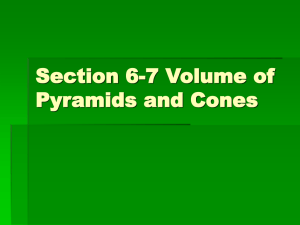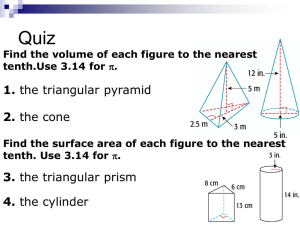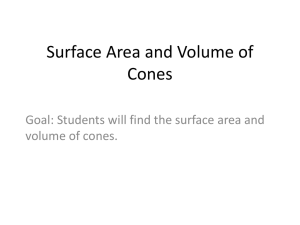Surface Areas of Pyramids and Cones
advertisement
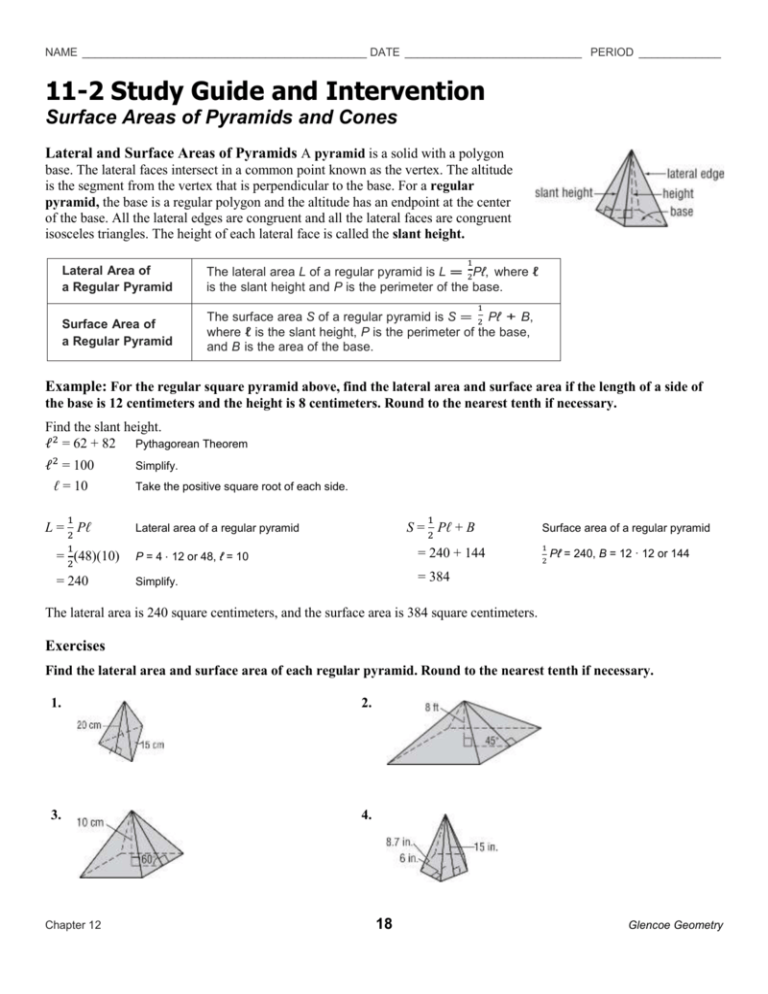
NAME _____________________________________________ DATE ____________________________ PERIOD _____________ 11-2 Study Guide and Intervention Surface Areas of Pyramids and Cones Lateral and Surface Areas of Pyramids A pyramid is a solid with a polygon base. The lateral faces intersect in a common point known as the vertex. The altitude is the segment from the vertex that is perpendicular to the base. For a regular pyramid, the base is a regular polygon and the altitude has an endpoint at the center of the base. All the lateral edges are congruent and all the lateral faces are congruent isosceles triangles. The height of each lateral face is called the slant height. 1 Lateral Area of a Regular Pyramid The lateral area L of a regular pyramid is L = 2Pℓ, where ℓ is the slant height and P is the perimeter of the base. Surface Area of a Regular Pyramid The surface area S of a regular pyramid is S = 2 Pℓ + B, where ℓ is the slant height, P is the perimeter of the base, and B is the area of the base. 1 Example: For the regular square pyramid above, find the lateral area and surface area if the length of a side of the base is 12 centimeters and the height is 8 centimeters. Round to the nearest tenth if necessary. Find the slant height. ℓ2 = 62 + 82 Pythagorean Theorem ℓ2 = 100 ℓ = 10 1 L = 2 Pℓ 1 Simplify. Take the positive square root of each side. 1 S = 2 Pℓ + B Lateral area of a regular pyramid = 2(48)(10) P = 4 ⋅ 12 or 48, ℓ = 10 = 240 + 144 = 240 Simplify. = 384 Surface area of a regular pyramid 1 2 Pℓ = 240, B = 12 · 12 or 144 The lateral area is 240 square centimeters, and the surface area is 384 square centimeters. Exercises Find the lateral area and surface area of each regular pyramid. Round to the nearest tenth if necessary. 1. 2. 3. 4. Chapter 12 18 Glencoe Geometry NAME _____________________________________________ DATE ____________________________ PERIOD _____________ 11-2 Study Guide and Intervention (continued) Surface Areas of Pyramids and Cones Lateral and Surface Areas of Cones A cone has a circular base and a vertex. The axis of the cone is the segment with endpoints at the vertex and the center of the base. If the axis is also the altitude, then the cone is a right cone. If the axis is not the altitude, then the cone is an oblique cone. Lateral Area of a Cone The lateral area L of a right circular cone is L = πrℓ, where r is the radius and ℓ is the slant height. Surface Area of a Cone The surface area S of a right cone is S = πrℓ + πr2 , where r is the radius and ℓ is the slant height. Example: For the right cone above, find the lateral area and surface area if the radius is 6 centimeters and the height is 8 centimeters. Round to the nearest tenth if necessary. Find the slant height. ℓ 2 = 62 + 82 Pythagorean Theorem 2 Simplify. ℓ = 10 Take the positive square root of each side. ℓ = 100 L = πrℓ S = πrℓ + 𝜋𝑟 2 Lateral area of a right cone Surface area of a right cone = π(6)(10) r = 6, ℓ = 10 ≈ 188.5 + π(62) πrℓ ≈ 188.5, r = 6 ≈ 188.5 Simplify. ≈ 301.6 Simplify. The lateral area is about 188.5 square centimeters and the surface area is about 301.6 square centimeters. Exercises Find the lateral area and surface area of each cone. Round to the nearest tenth if necessary. 1. 2. 3. 4. Chapter 12 19 Glencoe Geometry NAME _____________________________________________ DATE ____________________________ PERIOD _____________ 11-2 Study Guide and Intervention Volumes of Pyramids and Cones Volumes of Pyramids This figure shows a prism and a pyramid that have the same base and the same height. It is clear that the volume of the pyramid is less than the volume of the prism. More specifically, the volume of the pyramid is one-third of the volume of the prism. Volume of a Pyramid If a pyramid has a volume of V cubic units, a height of h units, and a base 1 with an area of B square units, then V = Bh. 3 Example: Find the volume of the square pyramid. 1 3 V = Bh 1 Volume of a pyramid = 3(8)(8)10 B = (8)(8), h = 10 ≈ 213.3 Multiply. The volume is about 213.3 cubic feet. Exercises Find the volume of each pyramid. Round to the nearest tenth if necessary. 1. 2. 3. 4. 5. 6. Chapter 12 19 Glencoe Geometry NAME _____________________________________________ DATE ____________________________ PERIOD _____________ 11-2 Study Guide and Intervention (continued) Volumes of Pyramids and Cones Volumes of Cones For a cone, the volume is one-third the product of the height and the area of the base. The base of a cone is a circle, so the area of the base is π𝑟 2 . Volume of a Cone If a cone has a volume of V cubic units, a height of h units, and the bases have a 1 radius of r units, then V = π𝑟2 h. 3 Example: Find the volume of the cone. 1 V = 3π𝑟 2 h 1 3 Volume of a cone = π(5)2 12 r = 5, h = 12 ≈ 314.2 Simplify. The volume of the cone is about 314.2 cubic centimeters. Exercises Find the volume of each cone. Round to the nearest tenth. 1. 2. 3. 4. 5. 6. Chapter 12 19 Glencoe Geometry
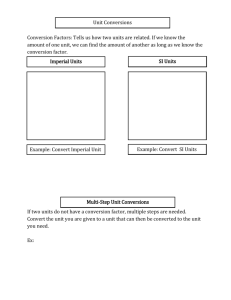
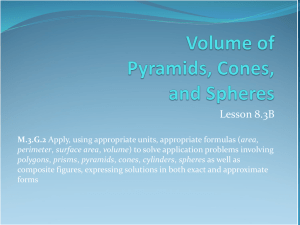
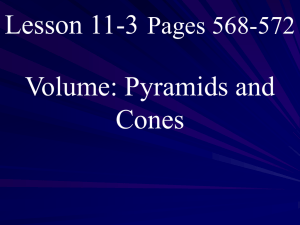
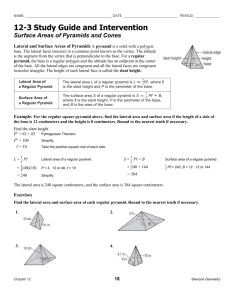
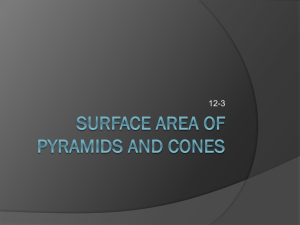
![Volume of Pyramids, Cones, and Spheres [12/4/2013]](http://s2.studylib.net/store/data/005724855_1-4c0eaf218975fc4d9fe792c18193e4dc-300x300.png)
